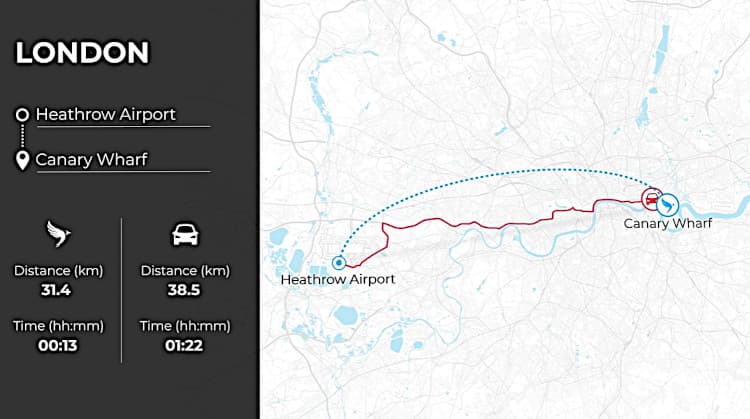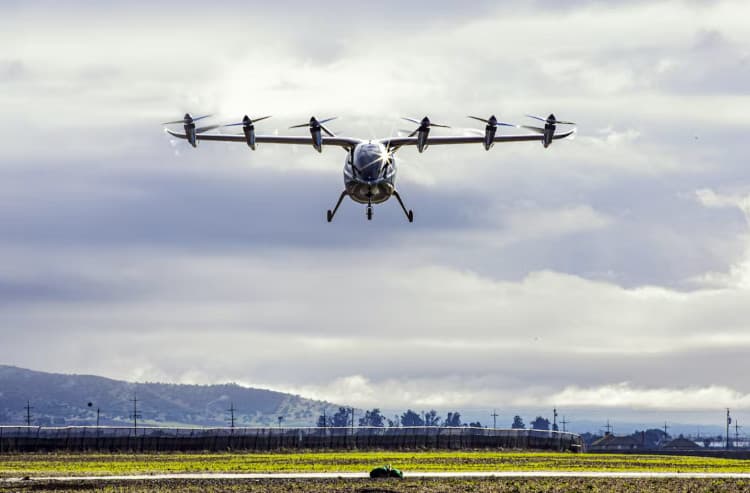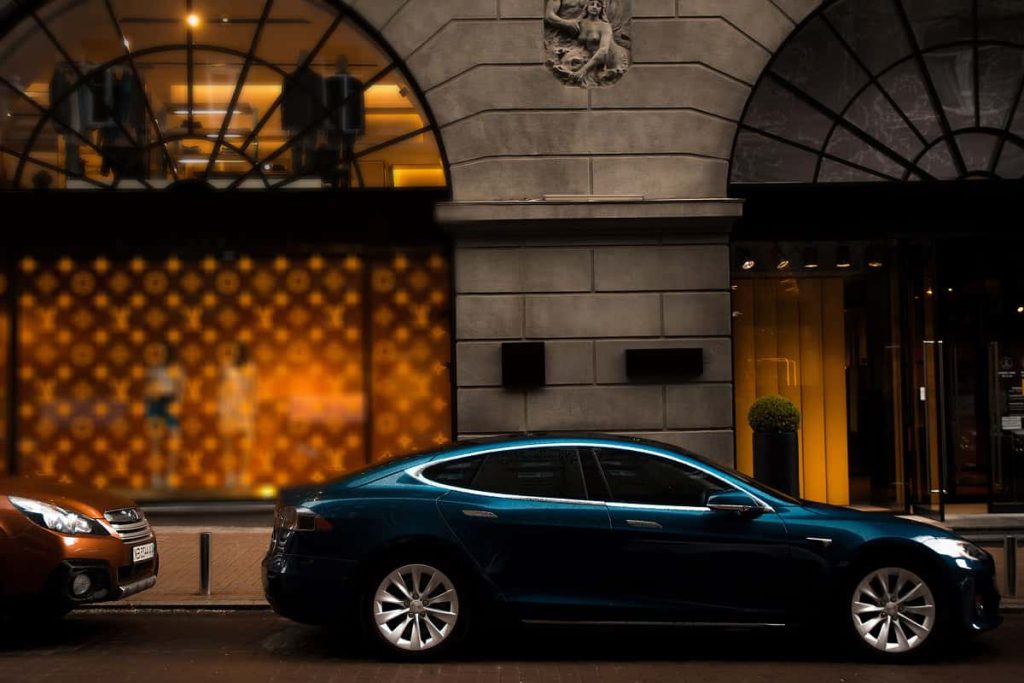The Best eVTOL Stocks for Investors to Watch
Table of contents

You’re either on the bus or off the bus. That’s a quote from Ken Kesey, the leader of the Merry Pranksters, a group of early hippies and hipsters who traveled on a bus called Further in 1964 and introduced LSD to the party scene. Kesey’s comment was both an inside joke – often one of the group’s too-stoned companions got left behind at any given time – and a metaphor for not being aboard with the plan.
The same could be said about the idea of flying cars. On one hand, Blade Runner spinners don’t seem all that preposterous anymore, especially if you can scale up production AND the infrastructure required to support what will eventually be a swarm of drone-like electric vehicles – also known as electric vertical takeoff and landing (eVTOL) aircraft. But is this idea of urban air mobility – featuring eVTOLs and other types of battery-powered and autonomous drones, vehicles, and droids – even achievable and profitable? Are we on the eVTOL or off the eVTOL? (Doesn’t really have the same ring, does it?)
And Then There Were Three eVTOL Stocks
We started talking about these questions last month with an article on the six publicly traded eVTOL stocks on the market. A few things became pretty clear. This is a risky, speculative play, with absolutely no immediate commercial viability. These companies are either still in some phase of R&D mode or at best testing pre-production models. Trying to put a price tag to the total addressable market is even more speculative than the trillion-dollar space industry. The most we can do at this point is identify leaders that might be worth upgrading to a long-term “like” in our Disruptive Tech Stock Catalog for future reference. But, at the end of the day, it may just not fly.
We already eliminated three candidates. We found some hangups with both EHang and Lilium. The former is not only a variable interest entity, which makes it an opaque stock investment with its own special set of risks, but it’s a favorite target of short sellers masquerading (legitimately or not) as whistleblowers. Ditto for Lilium regarding short sellers. Meanwhile, Blade Air Mobility is a rent-a-seat app on helicopters that’s a broader play on urban air mobility until the company acquires its own fleet from a third-party eVTOL manufacturer called Beta, which the New York Times recently featured.
That leaves us these three pre-revenue companies, all of which became publicly available through reverse mergers with special purpose acquisition companies (SPACs) last year. All of them are developing vectored-thrust, four-seater aircraft piloted by a human being, though each is headed in a different direction.
| Market Cap | Flight Tests | Key Partners | Business Model | |
| Joby Aviation (JOBY) | $3.2B | 1,000+ | Toyota Uber | Fleet Operator Only |
| Vertical Aerospace (EVTL) | $1.6B | 1 | Rolls Royce Honeywell Microsoft | Manufacturer Only |
| Archer Aviation (ACHR) | $900M | 0 | United Airlines | Hybrid |
We’ll try to do some apple to apple (if still somewhat subjective) comparisons in terms of each company’s maturity toward commercialization, the gravitas of their partnerships and customer contracts, and the business model for success.
Can Joby Aviation Get the Job Done?
This list should start with Joby for no other reason than company CEO JoeBen Bevirt’s father Jon was a member of the Merry Pranksters. So Bevirt basically grew up on a hippy commune in the 1970s and is named after a character in a novel by Ken Kesey, who is also like a godfather to the Joby founder. Who says you never learn anything in Forbes?
Of course, there are a few other reasons why Joby tops the list. The company is far and away the oldest eVTOL and most valuable of the trio, with a market cap of nearly $3.2 billion. Of course, just like most every other deSPAC company still alive today, Joby has dropped in value. It is down nearly 50% since it started trading under the JOBY ticker signal last August. Still, it exited the deal with about $1.6 billion on the balance sheet, despite a reported redemption rate of 63%. That means a majority of institutional investors decided to bail. The leadership team, however, did prove that this isn’t necessarily a fly-by-night operation: Both Joby and the SPAC, Reinvent Technology Partners, agreed to a long-term lock-up on founder shares for up to five years. There is a robust earnout structure with full vesting, but that doesn’t come to full fruition until the share price reaches $50 per share, implying a market cap of more than $30 billion.
Maturity level
Joby also tops another list. The Advanced Air Mobility (AAM) Reality Index from SMG Consulting has the company as the most likely to reach commercial production. That’s not too surprising. Last year alone, the Joby S4 flew more than 5,300 miles, generating 65 terabytes of flight test data, and demonstrated an endurance of almost 155 miles on a single charge. The company appears to be methodically moving toward certification from the Federal Aviation Administration (FAA). Last month, the Santa Cruz, California company began phase four of five to receive its Part 135 Air Carrier Certificate, which itself is only one of three major certifications required before the company can launch commercially in 2024.

It claims to be the first company to have agreed to a G-1 certification process with the FAA that outlines the criteria that need to be met in order for its aircraft to be certified for civil commercial operations. Flight testing resumed last month following a crash in February that’s being blamed on a component failure.
Gravitas
The company also claims to be the only eVTOL company to receive airworthiness approval from the U.S. Air Force. In addition, Joby is working closely with the Air Force through a multi-year program to test the S4 on a military base with the government even said to be kicking in $40 million. The company’s biggest partner and outside investor is Toyota, which has invested nearly $400 million in Joby to date. The Japanese automaker is working “shoulder-to-shoulder” with Joby, including on the design of a 450,000-square-foot manufacturing facility.

Another key investor and partner is Uber, which sold its own nascent eVTOL business to Joby in 2020 while concurrently investing more money into Joby directly.
Business Model
The two companies have also agreed to integrate their respective services into each other’s apps, which is a key to Joby’s overall strategy to offer multimodal transportation services. Joby plans to be vertically integrated, both manufacturing and operating its own fleet of ride-sharing eVTOLs. That means it will also need its own infrastructure for supporting its transportation network. This is where REEF Technology and Neighborhood Property Group come into the picture. The former is a major parking garage operator and the latter is a real estate acquisition company. Together, they will develop and acquire skyport sites, with an initial focus on big metropolitan areas such as Los Angeles, Miami, New York, and San Francisco.

In addition, Joby would tap into more than 5,000 existing heliports and regional airports across the United States.
Vertical Aerospace Has Yet to Take Off
Vertical Aerospace is a UK-based eVTOL company that is about half as old as Joby Aviation, as well as worth about half as much, with a market cap of about $1.6 billion. The company is led by British businessman Stephen Fitzpatrick, who also founded OVO Energy, one of the UK’s largest domestic energy supply companies. He may need to draw on his substantial wealth, estimated at about $875 million, to help his company reach maturity. It emerged from its SPAC deal with only about $300 million, and $200 million of that was actually from an investment firm that was announced well after the original merger. The rest of the money mainly came from private equity investments from previous investors and partners, so most of the SPAC trust fund evaporated before the ticker symbol changed in December.

Vertical Aerospace claims it can do the job of certifying and scaling production of its five-seat VX4 with just $250 million, so everything is cool. It might be possible to launch flying pigs with that much money, but probably not a major new transportation network.
Maturity Level
Vertical Aerospace falls just out of the top 10 eVTOL companies on the AAM Reality Index with a score of 7.2 out of 10. For comparison, Joby has the highest score at 8.7. Joby certainly gets the edge when it comes to transparency about its certification process, with lots of press releases covering each phase and step along the way. Vertical Aerospace? Not so much. The most we know is that the VA-X4, which is expected to reach speeds of 200 mph and range of 100 miles, will first be certified to the same standards as large commercial airliners under the European Union Aviation Safety Agency, which would also pave the way for FAA certification in the United States.

Vertical has yet to perform a flight test with a fully functioning prototype, despite promises to be ready for business by 2024. The AAM Reality Index may need a reality check.
Gravitas
No doubt Vertical Aerospace scores points for the companies on its roster of partnerships. Rolls Royce is co-developing a lightweight powertrain and flight control systems. Honeywell is behind the safety and operations systems. Microsoft is creating digital systems for both manufacturing and flying the aircraft.

In fact, it seems like most components of the VX4 have been farmed out to a third-party vendor, including electrical wiring systems (GKN Aerospace) and the carbon composite fuselage (Leonardo). There’s something to be said for not using first principles thinking because most third-party components have often already been used in the wild.
Business Model
Vertical Aerospace has no interest in running its own flying taxi service, at least not initially. Instead, the company will sell or lease eVTOLs to airlines like American, which is also an investor, or customers in cargo and medivac industries. The company claims to have more than $5.4 billion in pre-sales on about 1,350 aircraft. It also says that it only needs to offload 100 aircraft per year to break even. Let’s see if they are able to make one fly first.
Archer Quickly Getting Up to Speed
Finally, we have another California-based eVTOL company, Archer Aviation, which was founded just a couple of years ago. The company wasted little time before jumping on the SPAC train, leaving the station with $857.6 million. While institutional investors did pull some of their money out – the original deal was supposed to gross closer to $1.1 billion – Archer emerged in relatively good shape. The decision to revise the pre-merger company’s overall valuation may have helped stave off a bigger cash out among investors, according to reports. A bigger drag on the company’s momentum and cash may be an ongoing lawsuit with Wisk Aero, another eVTOL company that has accused Archer of stealing trade secrets. Archer countersued for $1 billion and recently announced that the U.S. Attorney’s Office has decided not to bring charges against one of its employees that is at the heart of the Wisk lawsuit.
Maturity Level
Despite only being founded in 2020, Archer has filed its G-1 certification with the FAA and received an airworthiness certificate for its Maker eVTOL last December, followed by the first successful hover flight.

That puts it ahead of Vertical Aerospace but still well behind Joby Aviation. Archer is No. 6 on the AAM Reality Index at 7.4 – just a tenth of a point behind Wisk. The production version of its prototype will be capable of traveling distances of up to 60 miles at 150 mph. Archer is also shooting for commercial production by 2024.
Gravitas
Archer lacks the sort of marquee names of the other two companies on this list. The exception is United Airlines, which has not only invested in the company but also ordered $1 billion worth of aircraft, with an additional $500 million option.
Business Model
Archer is splitting its business into two divisions. One will operate its own fleet of air taxis similar to Joby but also sell its aircraft directly to other companies like Vertical Aerospace. As just noted, it has already inked a deal with United Airlines worth up to $1.5 billion.

It is also working with REEF to find skyport space on top of parking garages.
Conclusion
Joby Aviation is the obvious choice among these three companies based on the maturity of its technology and business strategy. Each claims it will begin making money by 2024, which is probably the next time we’ll revisit this potentially lucrative (or loco) investment theme. We’re not entirely convinced that the “build it and they will come” urban air mobility thesis has the potential we’re being led to believe. When routes are being flown by eVTOL aircraft, and the “look at the celebrities who are using them” hype dies down, then maybe we’ll have a better understanding of how big the total opportunity is.












Very informative without hype
Thank you for the comment!
Thank you for this information. Now need to think about investing
You are quite welcome! Yes, always give yourself plenty of time to think about an investment before pulling the trigger.